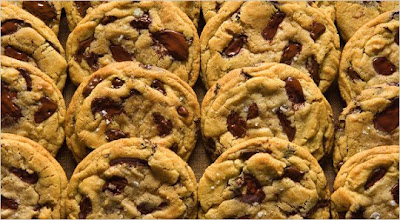Tuesday, 16 October 2012
About Cookies~~~
In the United States, Canada and Australia a cookie is a small, flat, baked treat, usually containing fat, flour, eggs and sugar. In most English-speaking countries outside North America, the most common word for this is biscuit; in many regions both terms are used, while in others the two words have different meanings. A cookie is a plain bun in Scotland,[2] while in the United States a biscuit is a kind of quick bread similar to a scone. In the United Kingdom, a cookie is referred to as a biscuit, although some types of cookies maintain this name, such as the American-inspired Maryland Cookies.
Its American name derives from the Dutch word koekje or (informal) koekie which means little cake, and arrived in American English through the Dutch in North America.
According to the Scottish National Dictionary, its Scottish name derives from the diminutive form (+ suffix -ie) of the word cook, giving the Middle Scots cookie, cooky or cu(c)kie. It also gives an alternative etymology, from the Dutch word koekje, the diminutive of koek, a cake. There was much trade and cultural contact across the North Sea between the Low Countries and Scotland during the Middle Ages, which can also be seen in the history of curling and, perhaps, golf.
Cookies are most commonly baked until crisp or just long enough that they remain soft, but some kinds of cookies are not baked at all. Cookies are made in a wide variety of styles, using an array of ingredients including sugars, spices, chocolate, butter, peanut butter, nuts or dried fruits. The softness of the cookie may depend on how long it is baked.
A general theory of cookies may be formulated this way. Despite its descent from cakes and other sweetened breads, the cookie in almost all its forms has abandoned water as a medium for cohesion. Water in cakes serves to make the base (in the case of cakes called "batter"[3]) as thin as possible, which allows the bubbles – responsible for a cake's fluffiness – to better form. In the cookie, the agent of cohesion has become some form of oil. Oils, whether they be in the form of butter, egg yolks, vegetable oils or lard are much more viscous than water and evaporate freely at a much higher temperature than water. Thus a cake made with butter or eggs instead of water is far denser after removal from the oven.
Oils in baked cakes do not behave as soda tends to in the finished result. Rather than evaporating and thickening the mixture, they remain, saturating the bubbles of escaped gases from what little water there might have been in the eggs, if added, and the carbon dioxide released by heating the baking powder. This saturation produces the most texturally attractive feature of the cookie, and indeed all fried foods: crispness saturated with a moisture (namely oil) that does not sink into it.
Subscribe to:
Post Comments (Atom)





No comments:
Post a Comment